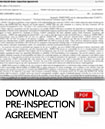Surface preparation and paint quality are the most important determinants of a paint’s life expectancy. Ultraviolet (UV) rays via sunshine can shorten life expectancy. Additionally, conditions of high humidity indoors or outdoors can affect the lifespan of these components, which is why they should be inspected and maintained seasonally.
| ADHESIVES, CAULK & PAINTS |
YEARS |
| Caulking (interior & exterior) |
5 to 10 |
| Construction Glue |
20+ |
| Paint (exterior) |
7 to 10 |
| Paint (interior) |
10 to 15 |
| Roofing Adhesives/Cements |
15+ |
| Sealants |
8 |
| Stains |
3 to 8 |
Appliance life expectancy depends to a great extent on the use it receives. Furthermore, consumers often replace appliances long before they become worn out due to changes in styling, technology and consumer preferences.
| APPLIANCES |
YEARS |
| Air Conditioner (window) |
5 to 7 |
| Compactor (trash) |
6 |
| Dehumidifier |
8 |
| Dishwasher |
9 |
| Disposal (food waste) |
12 |
| Dryer Vent (plastic) |
5 |
| Dryer Vent (steel) |
20 |
| Dryer (clothes) |
13 |
| Exhaust Fans |
10 |
| Freezer |
10 to 20 |
| Gas Oven |
10 to 18 |
| Hand Dryer |
10 to 12 |
| Humidifier (portable) |
8 |
| Microwave Oven |
9 |
Modern kitchens today are larger and more elaborate. Together with the family room, they now form the “great room.”
| CABINETRY & STORAGE |
YEARS |
| Bathroom Cabinets |
50+ |
| Closet Shelves |
100+ |
| Entertainment Center/Home Office |
10 |
| Garage/Laundry Cabinets |
70+ |
| Kitchen Cabinets |
50 |
| Medicine Cabinet |
25+ |
| Modular (stock manufacturing-type) |
50 |
Walls and ceilings last the full lifespan of the home.
| CEILINGS & WALLS |
YEARS |
| Acoustical Tile Ceiling |
40+ (older than 25 years may contain asbestos) |
| Ceramic Tile |
70+ |
| Concrete |
75+ |
| Gypsum |
75 |
| Wood Paneling |
20 to 50 |
| Suspended Ceiling |
25+ |
Natural stone countertops, which are less expensive than they were just a few years ago, are becoming more popular, and one can expect them to last a lifetime. Cultured marble countertops have a shorter life expectancy, however.
| COUNTERTOPS |
YEARS |
| Concrete |
50 |
| Cultured Marble |
20 |
| Natural Stone |
100+ |
| Laminate |
20 to 30 |
| Resin |
10+ |
| Tile |
100+ |
| Wood |
100+ |
Decks are exposed to a wide range of conditions in different climates, from wind and hail in some areas, to relatively consistent, dry weather in others. See FASTENERS & STEEL section for fasteners.
| DECKS |
YEARS |
| Deck Planks |
15 |
| Composite |
8 to 25 |
| Structural Wood |
10 to 30 |
Exterior fiberglass, steel and wood doors will last as long as the house, while vinyl and screen doors have a shorter life expectancy. The gaskets/weatherstripping of exterior doors may have to be replaced every 5 to 8 years.
| DOORS |
YEARS |
| Closet (interior) |
100+ |
| Fiberglass (exterior) |
100+ |
| Fire-Rated Steel (exterior) |
100+ |
| French (interior) |
30 to 50 |
| Screen (exterior) |
30 |
| Sliding Glass/Patio (exterior) |
20 (for roller wheel/track repair/replacement) |
| Vinyl (exterior) |
20 |
| Wood (exterior) |
100+ |
| Wood (hollow-core interior) |
20 to 30 |
| Wood (solid-core interior) |
30 to 100+ |
Copper-plated wiring, copper-clad aluminum, and bare copper wiring are expected to last a lifetime, whereas electrical accessories and lighting controls, such as dimmer switches, may need to be replaced after 10 years. GFCIs could last 30 years, but much less if tripped regularly.
Remember that faulty, damaged or overloaded electrical circuits or equipment are the leading cause of house fires, so they should be inspected regularly and repaired or updated as needed.
| ELECTRICAL |
YEARS |
| Accessories |
10+ |
| Arc-Fault Circuit Interrupters (AFCIs) |
30 |
| Bare Copper |
100+ |
| Bulbs (compact fluorescent) |
8,000 to 10,000+ hours |
| Bulbs (halogen) |
4,000 to 8,000+ hours |
| Bulbs (incandescent) |
1,000 to 2,000+ hours |
| Bulbs (LED) |
30,000 to 50,000+ hours |
| Copper-Clad Aluminum |
100+ |
| Copper-Plated |
100+ |
| Fixtures |
40 |
| Ground-Fault Circuit Interrupters (GFCIs) |
up to 30 |
| Lighting Controls |
30+ |
| Residential Propane Backup Generators |
12 |
| Service Panel |
60 |
| Solar Panels |
20 to 30 |
| Solar System Batteries |
3 to 12 |
| Wind Turbine Generators |
20 |
Floor and roof trusses and laminated strand lumber are durable household components, and engineered trim may last 30 years.
| ENGINEERED LUMBER |
YEARS |
| Engineered Joists |
80+ |
| Laminated Strand Lumber |
100+ |
| Laminated Veneer Lumber |
80+ |
| Trusses |
100+ |
Fastener manufacturers do not give lifespans for their products because they vary too much based on where the fasteners are installed in a home, the materials in which they’re installed, and the local climate and environment. However, inspectors can use the guidelines below to make educated judgments about the materials they inspect.
| FASTENERS, CONNECTORS & STEEL |
YEARS |
| Adjustable Steel Columns |
50+ |
| Fasteners (bright) |
25 to 60 |
| Fasteners (copper) |
65 to 80+ |
| Fasteners (galvanized) |
10+ |
| Fasteners (electro-galvanized) |
15 to 45 |
| Fasteners (hot-dipped galvanized) |
35 to 60 |
| Fasteners (stainless) |
65 to 100+ |
| Steel Beams |
200+ |
| Steel Columns |
100+ |
| Steel Plates |
100+ |
Flooring life is dependent on maintenance and the amount of foot traffic the floor endures.
| FLOORING |
YEARS |
| All Wood Floors |
100+ |
| Bamboo |
100+ |
| Brick Pavers |
100+ |
| Carpet |
8 to 10 |
| Concrete |
50+ |
| Engineered Wood |
50+ |
| Exotic Wood |
100+ |
| Granite |
100+ |
| Laminate |
15 to 25 |
| Linoleum |
25 |
| Marble |
100+ |
| Other Domestic Wood |
100+ |
| Slate |
100 |
| Terrazzo |
75+ |
| Tile |
75 to 100 |
| Vinyl |
25 |
Concrete and poured-block footings and foundations will last a lifetime, assuming they were properly built. Waterproofing with bituminous coating lasts 10 years, but if it cracks, it is immediately damaged.
| FOUNDATIONS |
YEARS |
| Baseboard Waterproofing System |
50 |
| Bituminous-Coating Waterproofing |
10 |
| Concrete Block |
100+ |
| Insulated Concrete Forms (ICFs) |
100 |
| Post and Pier |
20 to 65 |
| Post and Tensioned Slab on Grade |
100+ |
| Poured-Concrete Footings and Foundation |
100+ |
| Slab on Grade (concrete) |
100 |
| Wood Foundation |
5 to 40 |
| Permanent Wood Foundation (PWF; treated) |
75 |
Framing and structural systems have extended longevities; poured-concrete systems, timber frame houses and structural insulated panels will all last a lifetime.
| FRAMING |
YEARS |
| Log |
80 to 200 |
| Poured-Concrete Systems |
100+ |
| Steel |
100+ |
| Structural Insulated Panels (SIPs) |
100+ |
| Timber Frame |
100+ |
The quality and frequency of use will affect the longevity of garage doors and openers.
| GARAGES |
YEARS |
| Garage Doors |
20 to 25 |
| Garage Door Openers |
10 to 15 |
Home technology systems have diverse life expectancies and may have to be upgraded due to evolution in technology.
| HOME TECHNOLOGY |
YEARS |
| Built-In Audio |
20 |
| Carbon Monoxide Detectors* |
5 |
| Door Bells |
45 |
| Home Automation System |
5 to 50 |
| Intercoms |
20 |
| Security System |
5 to 20 |
| Smoke/Heat Detectors* |
less than 10 |
| Wireless Home Networks |
5+ |
* Batteries should be changed at least annually.
Thermostats may last 35 years but they are usually replaced before they fail due to technological improvements.
| HVAC |
YEARS |
| Air Conditioner (central) |
7 to 15 |
| Air Exchanger |
15 |
| Attic Fan |
15 to 25 |
| Boiler |
40 |
| Burner |
10+ |
| Ceiling Fan |
5 to 10 |
| Condenser |
8 to 20 |
| Dampers |
20+ |
| Dehumidifier |
8 |
| Diffusers, Grilles and Registers |
25 |
| Ducting |
60 to 100 |
| Electric Radiant Heater |
40 |
| Evaporator Cooler |
15 to 25 |
| Furnace/div> |
15 to 25 |
| Gas Fireplace |
15 to 25 |
| Heat Exchanger |
10 to 15 |
| Heat Pump |
10 to 15 |
| Heat-Recovery Ventilator |
20 |
| Hot-Water and Steam-Radiant Boiler |
40 |
| Humidifier |
12 |
| Induction and Fan-Coil Units |
10 to 15 |
| Chimney Cap (concrete) |
100+ |
| Chimney Cap (metal) |
10 to 20 |
| Chimney Cap (mortar) |
15 |
| Chimney Flue Tile |
40 to 120 |
| Thermostats |
35 |
| Ventilator |
7 |
As long as they are not punctured, cut or burned and are kept dry and away from UV rays, cellulose, fiberglass and foam insulation materials will last a lifetime. This is true regardless of whether they were installed as loose-fill, housewrap or batts/rolls.
| INSULATION & INFILTRATION BARRIERS |
YEARS |
| Batts/Rolls |
100+ |
| Black Paper (felt paper) |
15 to 30 |
| Cellulose |
100+ |
| Fiberglass |
100+ |
| Foamboard |
100+ |
| Housewrap |
80+ |
| Liquid-Applied Membrane |
50 |
| Loose-Fill |
100+ |
| Rock Wool |
100+ |
| Wrap Tape |
80+ |
Masonry is one of the most enduring household components. Fireplaces, chimneys and brick veneers can last the lifetime of a home.
| MASONRY & CONCRETE |
YEARS |
| Brick |
100+ |
| Insulated Concrete Forms (hybrid block) |
100+ |
| Concrete Masonry Units (CMUs) |
100+ |
| Man-Made Stone |
25 |
| Masonry Sealant |
2 to 20 |
| Stone |
100+ |
| Stucco/EIFS |
50+ |
| Veneer |
100+ |
Custom millwork and stair parts will last a lifetime and are typically only upgraded for aesthetic reasons.
| MOLDING, MILLWORK & TRIM |
YEARS |
| Attic Stairs (pull-down) |
50 |
| Custom Millwork |
100+ |
| Pre-Built Stairs |
100+ |
| Stair Parts |
100+ |
| Stairs |
100+ |
The lifetime of any wood product depends heavily on moisture intrusion.
| PANELS |
YEARS |
| Flooring Underlayment |
25 |
| Hardboard |
40 |
| Particleboard |
60 |
| Plywood |
100 |
| Softwood |
30 |
| Oriented Strand Board (OSB) |
60 |
| Wall Panels |
100+ |
The quality of plumbing fixtures varies dramatically. The mineral content of water can shorten the life expectancy of water heaters and clog showerheads. Also, some finishes may require special maintenance with approved cleaning agents per the manufacturers in order to last their expected service lives.
| PLUMBING, FIXTURES & FAUCETS |
YEARS |
| ABS and PVC Waste Pipe |
50 to 80 |
| Accessible/ADA Handles |
100+ |
| Acrylic Kitchen Sink |
50 |
| Cast-Iron Bathtub |
100 |
| Cast-Iron Waste Pipe (above ground) |
60 |
| Cast-Iron Waste Pipe (below ground) |
50 to 60/div> |
| Concrete Waste Pipe |
100+ |
| Copper Water Lines |
70 |
| Enameled Steel Kitchen Sink |
5 to 10+ |
| Faucets and Spray Hose |
15 to 20 |
| Fiberglass Bathtub and Shower |
20 |
| Gas Lines (black steel) |
75 |
| Gas Lines (flex) |
30 |
| Hose Bibs |
20 to 30 |
| Instant (on-demand) Water Heater |
10 |
| PEX |
40 |
| Plastic Water Lines |
75 |
| Saunas/Steam Room |
15 to 20 |
| Sewer Grinder Pump |
10 |
| Shower Enclosure/Module |
50 |
| Shower Doors |
20 |
| Showerheads |
100+ (if not clogged by mineral/other deposits) |
| Soapstone Kitchen Sink |
100+ |
| Sump Pump |
7 |
| Toilet Tank Components |
5 |
| Toilets, Bidets and Urinals |
100+ |
| Vent Fan (ceiling) |
5 to 10 |
| Vessel Sink (stone, glass, porcelain, copper) |
5 to 20+ |
| Water Heater (conventional) |
6 to 12 |
| Water Line (copper) |
50 |
| Water Line (plastic) |
50 |
| Well Pump |
15 |
| Water Softener |
20 |
| Whirlpool Tub |
20 to 50 |
Radon systems have but one moving part: the radon fan.
| RADON SYSTEMS |
YEARS |
| Air Exchanger |
15 |
| Barometric Backdraft Damper/Fresh-Air Intake |
20 |
| Caulking |
5 to 10 |
| Labeling |
25 |
| Manometer |
15 |
| Piping |
50+ |
| Radon Fan |
5 to 8 |
The life of a roof depends on local weather conditions, building and design, material quality, and adequate maintenance. Hot climates drastically reduce asphalt shingle life. Roofs in areas that experience severe weather, such as hail, tornadoes and/or hurricanes may also experience a shorter-than-normal lifespan overall or may incur isolated damage that requires repair in order to ensure the service life of the surrounding roofing materials.
| ROOFING |
YEARS |
| Aluminum Coating |
3 to 7 |
| Asphalt Shingles (3-tab) |
20 |
| Asphalt (architectural) |
30 |
| BUR (built-up roofing) |
30 |
| Cellulose Fiber |
20 |
| Clay/Concrete |
100+ |
| Coal and Tar |
30 |
| Copper |
70+ |
| EPDM (ethylene propylene diene monomer) Rubber |
15 to 25 |
| Fiber Cement |
25 |
| Green (vegetation-covered) |
5 to 40 |
| Metal |
40 to 80 |
| Modified Bitumen |
20 |
| Simulated Slate |
10 to 35 |
| Slate |
60 to 150 |
| TPO |
7 to 20 |
| Wood |
30 |
Outside siding materials typically last a lifetime. Some exterior components may require protection through appropriate paints or sealants, as well as regular maintenance. Also, while well-maintained and undamaged flashing can last a long time, it is their connections that tend to fail, so seasonal inspection and maintenance are strongly recommended.
| SIDINGS, FLASHING & ACCESSORIES |
YEARS |
| Aluminum Siding |
25 to 40+ |
| Aluminum Gutters, Downspouts, Soffit and Fascia |
20 to 40+ |
| Asbestos Shingle |
100 |
| Brick |
100+ |
| Cementitious |
100+ |
| Copper Downspouts |
100 |
| Copper Gutters |
50+ |
| Engineered Wood |
100+ |
| Fiber Cement |
100+ |
| Galvanized Steel Gutters/Downspouts |
20 |
| Manufactured Stone |
100+ |
| Stone |
100+ |
| Stucco/EIFS |
50+ |
| Trim |
25 |
| Vinyl Siding |
60 |
| Vinyl Gutters and Downspouts |
25+ |
| Wood/Exterior Shutters |
20 |
Site and landscaping elements have life expectancies that vary dramatically.
| SITE & LANDSCAPING |
YEARS |
| American Red Clay |
100+ |
| Asphalt Driveway |
15 to 20 |
| Brick and Concrete Patio |
15 to 25 |
| Clay Paving |
100+ |
| Concrete Walks |
40 to 50 |
| Controllers |
15 |
| Gravel Walks |
4 to 6 |
| Mulch |
1 to 2 |
| Polyvinyl Fencing |
100+ |
| Sprinkler Heads |
10 to 14 |
| Underground PVC Piping |
60+ |
| Valves |
20 |
| Wood Chips |
1 to 5 |
| Wood Fencing |
20 |
Swimming pools are comprised of many systems and components, all with varying life expectancies.
| SWIMMING POOLS |
YEARS |
| Concrete Shell |
25+ |
| Cover |
7 |
| Diving Board |
10 |
| Filter and Pump |
10 |
| Interior Finish |
10 to 35 |
| Vinyl Liner |
10 |
| Pool Water Heater |
8 |
| Waterline Tile |
15+ |
Aluminum windows are expected to last between 15 and 20 years, while wooden windows should last nearly 30 years.
| WINDOWS |
YEARS |
| Aluminum/Aluminum-Clad |
15 to 20 |
| Double-Pane |
8 to 20 |
| Skylights |
10 to 20 |
| Window Glazing |
10+ |
| Vinyl Windows |
20 to 40 |
| Wood |
30+ |
Note: Life expectancy varies with usage, weather, installation, maintenance and quality of materials. This list should be used only as a general guideline and not as a guarantee or warranty regarding the performance or life expectancy of any appliance, product, system or component.
 Call Us Today: (518) 593-0642
Call Us Today: (518) 593-0642 







